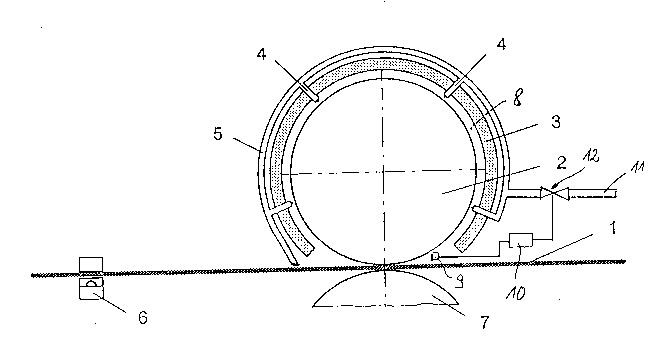Some of the information on this Web page has been provided by external sources. The Government of Canada is not responsible for the accuracy, reliability or currency of the information supplied by external sources. Users wishing to rely upon this information should consult directly with the source of the information. Content provided by external sources is not subject to official languages, privacy and accessibility requirements.
Any discrepancies in the text and image of the Claims and Abstract are due to differing posting times. Text of the Claims and Abstract are posted:
| (12) Patent Application: | (11) CA 2150176 |
|---|---|
| (54) English Title: | HEATABLE ROLL FOR THE TREATMENT OF WEBS OF MATERIAL AS WELL AS METHOD FOR THEIR OPERATION |
| (54) French Title: | ROULEAU CHAUFFANT UTILISE DANS LE TRAITEMENT DE BANDES DE MATERIAU, ET MODE DE FONCTIONNEMENT |
| Status: | Deemed Abandoned and Beyond the Period of Reinstatement - Pending Response to Notice of Disregarded Communication |
| (51) International Patent Classification (IPC): |
|
|---|---|
| (72) Inventors : |
|
| (73) Owners : |
|
| (71) Applicants : |
|
| (74) Agent: | SWABEY OGILVY RENAULT |
| (74) Associate agent: | |
| (45) Issued: | |
| (22) Filed Date: | 1995-05-25 |
| (41) Open to Public Inspection: | 1995-11-27 |
| Availability of licence: | N/A |
| Dedicated to the Public: | N/A |
| (25) Language of filing: | English |
| Patent Cooperation Treaty (PCT): | No |
|---|
| (30) Application Priority Data: | ||||||
|---|---|---|---|---|---|---|
|
A jacket with a thermally insulating layer partially
surrounds, at a small spacing, a heatable roll which serves
for the treatment of webs of material, in particular paper
webs. Under production conditions the jacket reduces heat
losses from the roll through convection and radiation to the
environment. The jacket has a device which, with an
interruption of production, ensures a forced convection at
the heated roll for the cooling of the surface to a
temperature level which is same or only insubstantially
higher than in the production state. Several cooling nozzles
are conceivable for the said apparatus which are secured to
the jacket and direct a coolant onto the roll surface.
Note: Claims are shown in the official language in which they were submitted.
Note: Descriptions are shown in the official language in which they were submitted.

2024-08-01:As part of the Next Generation Patents (NGP) transition, the Canadian Patents Database (CPD) now contains a more detailed Event History, which replicates the Event Log of our new back-office solution.
Please note that "Inactive:" events refers to events no longer in use in our new back-office solution.
For a clearer understanding of the status of the application/patent presented on this page, the site Disclaimer , as well as the definitions for Patent , Event History , Maintenance Fee and Payment History should be consulted.
| Description | Date |
|---|---|
| Inactive: IPC from MCD | 2006-03-11 |
| Inactive: IPC from MCD | 2006-03-11 |
| Inactive: IPC from MCD | 2006-03-11 |
| Inactive: IPC from MCD | 2006-03-11 |
| Time Limit for Reversal Expired | 2000-05-25 |
| Application Not Reinstated by Deadline | 2000-05-25 |
| Deemed Abandoned - Failure to Respond to Maintenance Fee Notice | 1999-05-25 |
| Application Published (Open to Public Inspection) | 1995-11-27 |
| Abandonment Date | Reason | Reinstatement Date |
|---|---|---|
| 1999-05-25 |
The last payment was received on 1998-05-05
Note : If the full payment has not been received on or before the date indicated, a further fee may be required which may be one of the following
Patent fees are adjusted on the 1st of January every year. The amounts above are the current amounts if received by December 31 of the current year.
Please refer to the CIPO
Patent Fees
web page to see all current fee amounts.
| Fee Type | Anniversary Year | Due Date | Paid Date |
|---|---|---|---|
| MF (application, 3rd anniv.) - standard | 03 | 1998-05-25 | 1998-05-05 |
Note: Records showing the ownership history in alphabetical order.
| Current Owners on Record |
|---|
| VOITH SULZER FINISHING GMBH |
| Past Owners on Record |
|---|
| DIRK CRAMER |
| HANS-ROLF CONRAD |